It looks like a meteor strike: From out of nowhere, a huge clearing appears in the jungle — a deep rust-colored pit surrounded by mounds of dirt and thick stands of trees pushed to the side in dense piles of overturned soil.
However, this is no act of nature. It is the result of the steady labor of fewer than a dozen barefoot men, who have blasted away at the earth for three days with high-pressure water hoses and earth-movers, searching for gold and destroying a swathe of rainforest.
The miners near a small town called Nieuw Koffiekamp, at the edge of Suriname’s vast rainforest hinterland, planned to spend a week tearing into the soil and filtering it through toxic mercury. Then, they will start over again somewhere else.
Juergen Plein, a 29-year-old miner, said he needs the work and doesn’t know any other way to get at the precious metal.
“I think about it,” Plein, nearly shouting over the roar of generators, said of the damage. “But survival comes first.”
Thanks to record gold prices, hundreds of small-scale mining operations are proliferating along the northeastern shoulder of South America. Small-scale miners produced a record of nearly 16.5 tonnes of gold last year, according to Suriname’s government.
Miners are tearing up trees, poisoning creeks with mercury and, in some places, erecting makeshift jungle towns with shops, prostitutes and churches. In their wake is a wasteland, said Dominiek Plouvier, regional representative of the WWF.
“All the top soil has been removed, it’s finished,” Plouvier said. “This ecosystem is very fragile. It is very difficult to get it back in these areas.”
The miners, many of them illegal migrants from Brazil, are scattered throughout the northern Amazon basin, occasionally fleeing crackdowns by police or the military in Venezuela, French Guiana and Guyana. However, nothing seems to stop them in Suriname, a country rich in resources with the weakest law enforcement in the region.
The new government that took power this month is expected to at least attempt to address the issue. Vice President Robert Ameerali said they would seek to reduce the use of mercury, which is illegal but widely available to miners who use it to separate gold from ore.
Mining consultant Chris Healy said Suriname should set aside areas for small-scale miners and regulate their activities, providing training and assistance to acquire less-polluting technology.
“You can make all kinds of laws and enforcement,” he said. “But there is nobody there to enforce it.”
An estimated 14,000 small-scale miners and service providers work in Suriname’s interior, said Marieke Heemskerk, a consultant and anthropologist who has tracked mining in the country for years. The rampant and unrestricted subletting of mine concessions is illegal, but it’s largely tolerated by the government — and it gives people work.
Mining is a touchy subject in Suriname, which has gained praise over the years from environmentalists for placing limits on logging and setting aside large rainforest preserves. The metal, shipped to refiners in North America and Europe, is one of the main exports in a largely poor country of nearly 500,000 people that is about the size of Georgia. It is an important source of income, particularly for Maroons, the descendants of runaway slaves, and Amerindians in the interior, who make money providing transportation or selling access to their land concessions.
In recent years, small-scale miners have grown more destructive as they use more heavy equipment such as earthmovers — flown into remote spots in the jungle or shipped down rivers — to work faster or in more remote, larger areas.
In a country with few real roads, it is difficult to find the mines, but from the air it’s a different story.
Satellite analysis of the scarred earth and diverted waterways shows that miners in Suriname have deforested at least 30,000 hectares and damaged more than 2,200km of river over the past decade, Plouvier said. WWF estimates the small-scale mining is also responsible for some 20 tonnes of mercury entering the environment and posing a risk to people through fish consumption.
Some parts of Suriname have become like the Wild West, only with all-terrain-vehicles and satellite dishes.
Journalists visited a mining area about 160km south of the capital Paramaribo, reachable only by boat, followed by a bone-jarring ATV ride through the dense jungle.
All around were the huge telltale piles of discarded soil and open pits. In the middle of a network of trails was a town of sorts.
The one-street settlement — more of an outpost in the jungle — was a dusty clearing and a line of simple, plywood structures. There were two markets, two churches and four bars, festooned with small Brazilian flags. In the lull of a rainy afternoon, bored prostitutes sat watching TV until the customers returned. Plastic bottles, beer cans and other trash was strewn about everywhere or smoldering in burning piles.
Ines Aboikonbie, who runs a bar with her Brazilian husband, said the settlement of about 200 would probably move soon along with the miners in search of gold.
The largest gold mine in the country, at Rosebel not far from Nieuw Koffiekamp, is run by Toronto-based IAMGOLD Corp and employs 1,100 people. The mine produced nearly 12 metric tonnes of gold last year, but while all mining draws critics, environmentalists are more worried about the damage done by small operators over a wide expanse.
IAMGOLD spokesman Bob Tait said many people — including several hundred it accuses of illegally mining on its concession — prefer the informal sector because they like the flexibility and dream of finding riches.
“Sometimes it’s hard for us to compete,” he said.
Plein, the miner at Nieuw KoffieKamp, is a thin man with a scraggly beard and dreadlocks pulled back behind his head. He said the amount his crew earns depends on how much gold they find and how much fuel they use trying to find it — they might gross US$40,000 before paying for the equipment rental and dividing the proceeds.
One of the biggest challenges, he said, is finding a place to search amid fierce competition and competing claims on land.
“It’s hard,” said Plein, a Maroon who grew up in the town of dirt streets and small wooden homes. “But I’m used to it.”

‘EYE FOR AN EYE’: Two of the men were shot by a male relative of the victims, whose families turned down the opportunity to offer them amnesty, the Supreme Court said Four men were yesterday publicly executed in Afghanistan, the Supreme Court said, the highest number of executions to be carried out in one day since the Taliban’s return to power. The executions in three separate provinces brought to 10 the number of men publicly put to death since 2021, according to an Agence France-Presse tally. Public executions were common during the Taliban’s first rule from 1996 to 2001, with most of them carried out publicly in sports stadiums. Two men were shot around six or seven times by a male relative of the victims in front of spectators in Qala-i-Naw, the center

Incumbent Ecuadoran President Daniel Noboa on Sunday claimed a runaway victory in the nation’s presidential election, after voters endorsed the young leader’s “iron fist” approach to rampant cartel violence. With more than 90 percent of the votes counted, the National Election Council said Noboa had an unassailable 12-point lead over his leftist rival Luisa Gonzalez. Official results showed Noboa with 56 percent of the vote, against Gonzalez’s 44 percent — a far bigger winning margin than expected after a virtual tie in the first round. Speaking to jubilant supporters in his hometown of Olon, the 37-year-old president claimed a “historic victory.” “A huge hug

Two Belgian teenagers on Tuesday were charged with wildlife piracy after they were found with thousands of ants packed in test tubes in what Kenyan authorities said was part of a trend in trafficking smaller and lesser-known species. Lornoy David and Seppe Lodewijckx, two 19-year-olds who were arrested on April 5 with 5,000 ants at a guest house, appeared distraught during their appearance before a magistrate in Nairobi and were comforted in the courtroom by relatives. They told the magistrate that they were collecting the ants for fun and did not know that it was illegal. In a separate criminal case, Kenyan Dennis

The US will help bolster the Philippines’ arsenal and step up joint military exercises, Manila’s defense chief said, as tensions between Washington and China escalate. The longtime US ally is expecting a sustained US$500 million in annual defense funding from Washington through 2029 to boost its military capabilities and deter China’s “aggression” in the region, Philippine Secretary of Defense Gilberto Teodoro said in an interview in Manila on Thursday. “It is a no-brainer for anybody, because of the aggressive behavior of China,” Teodoro said on close military ties with the US under President Donald Trump. “The efforts for deterrence, for joint resilience